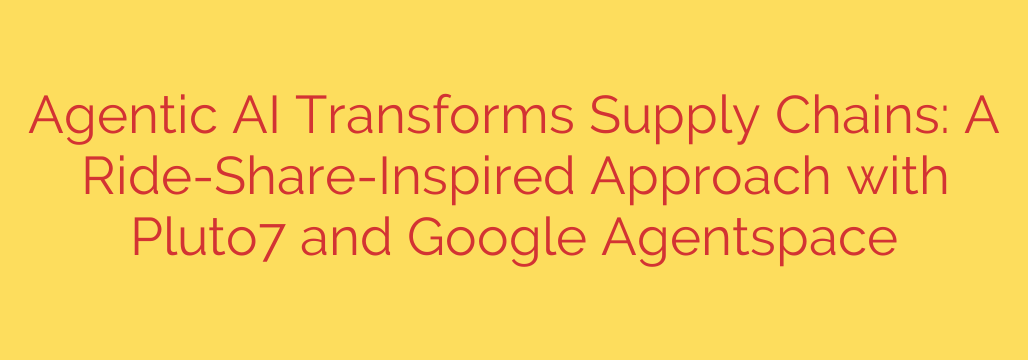
The Future of Supply Chains: How Agentic AI is Building a Smarter, Faster Network
For decades, the global supply chain has operated on a foundation of forecasts, batch processing, and siloed communication. While functional, this model has proven to be brittle and slow to adapt, as recent global disruptions have painfully demonstrated. A delayed shipment or a factory shutdown can send shockwaves through an entire network, with businesses often learning about the problem far too late.
But a revolutionary shift is underway, moving us from this reactive model to a proactive, intelligent, and highly optimized future. This transformation is powered by Agentic AI, a new approach that promises to rebuild supply chain management from the ground up, making it as dynamic and responsive as a modern ride-sharing service.
The Problem with Today’s Supply Chain
Traditional supply chains are hampered by fundamental limitations:
- Information Silos: Data is often locked away in separate ERPs, warehouse management systems, and logistics platforms. Getting a complete, real-time picture is nearly impossible.
- Reactive Nature: Companies typically react to disruptions after they happen, scrambling to find alternatives and manage the fallout.
- Inefficiency: Assets like trucks, warehouse space, and manufacturing capacity are often underutilized due to poor coordination and planning based on outdated information.
A New Vision: The “Ride-Share” Model for Logistics
Imagine how a service like Uber or Lyft operates. A rider (demand) opens an app and requests a ride. The platform instantly analyzes nearby drivers (supply), considering factors like proximity, traffic, and vehicle size, and dispatches the optimal choice.
Now, apply this logic to the supply chain. A customer order is the “rider,” and available trucks, warehouse slots, or production lines are the “drivers.” An intelligent AI platform sits in the middle, orchestrating everything in real-time.
This is the core concept behind the agentic transformation. Instead of rigid, pre-planned routes, we have a fluid network where demand is dynamically matched with the best available supply second by second.
What is Agentic AI and How Does It Power This Change?
Agentic AI is not just another analytics tool. It is a system of multiple, autonomous AI “agents” that work collaboratively to achieve a common goal. Each agent is a specialized software program designed to represent and manage a specific part of the supply chain.
- An Inventory Agent might monitor stock levels at a specific warehouse.
- A Logistics Agent could represent a fleet of trucks, knowing their current location, capacity, and availability.
- A Manufacturing Agent can track production schedules and capacity on a factory floor.
These agents don’t just report data; they perceive their digital environment, communicate with other agents, negotiate, and take action to solve problems autonomously. When a new order (a demand signal) is created, it is broadcast to the network. Relevant supply agents (like a warehouse with stock and a truck with available space) can then “bid” to fulfill that order. The system instantly selects the most efficient and cost-effective combination to get the job done.
The Tangible Benefits of an Agentic Supply Chain
Adopting this model moves businesses from simply managing their supply chain to optimizing it continuously. The key advantages are profound:
- Unprecedented Resilience: If a shipment is delayed, the network doesn’t break. The relevant agents immediately recognize the disruption and collaborate to find the next best alternative, automatically re-routing goods or sourcing from a different location without human intervention.
- Radical Efficiency and Cost Reduction: By having a complete view of all available assets, the system ensures maximum utilization. This means fewer empty trucks on the road, less idle time at warehouses, and optimized production schedules, all of which translate directly to lower operational costs.
- Real-Time Visibility and Control: Forget waiting for end-of-day reports. An agentic system provides a live, dynamic view of your entire supply chain, allowing you to see exactly where everything is and how operations are performing at any given moment.
- Democratized Access: Just as ride-sharing allowed individual drivers to compete with large taxi fleets, an agent-driven supply network allows smaller suppliers and logistics providers to participate more easily. Their “agent” can make their capacity visible to the network, creating a more competitive and robust ecosystem.
Key Steps to Prepare for an Agentic Future
Transitioning to this new model requires a strategic approach. For any organization looking to future-proof its operations, the focus should be on these key areas:
- Build a Solid Data Foundation: AI agents thrive on high-quality, real-time data. Integrating your disparate systems (ERPs, IoT sensors, supplier data) into a clean, accessible data lake or warehouse is the essential first step.
- Start Small and Scale Smart: You don’t need to overhaul your entire operation overnight. Begin with a pilot project focused on a specific area of pain, such as outbound logistics or inventory management for a single product line. Prove the value and then scale the solution across the organization.
- Prioritize Security and Governance: In a system where AI agents can take autonomous action, security is paramount. Implement robust access controls, data encryption, and transparent auditing to ensure that all actions are authorized, tracked, and aligned with business rules.
The shift toward Agentic AI is not a distant sci-fi concept; the technology is here, and early adopters are already building a significant competitive advantage. By embracing this intelligent, autonomous, and collaborative model, businesses can finally move beyond simply surviving disruptions and begin building the truly resilient and efficient supply chains of the future.
Source: https://cloud.google.com/blog/topics/partners/pluto7-pi-agent-ai-meets-agentspace/








